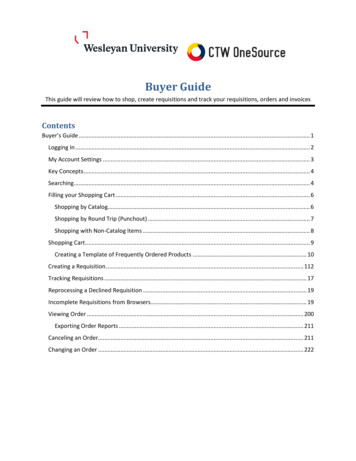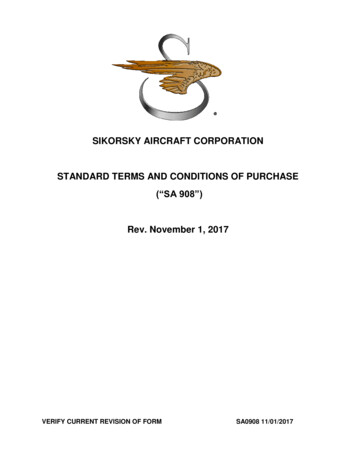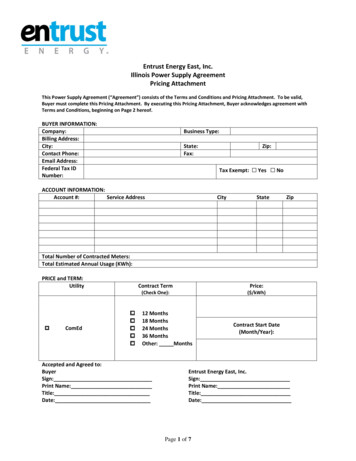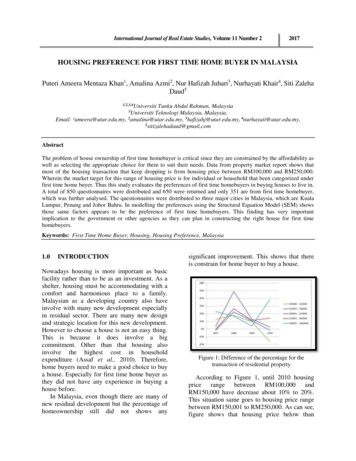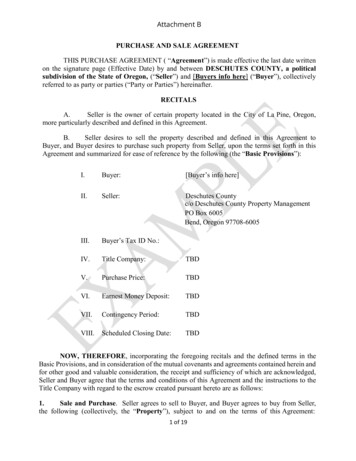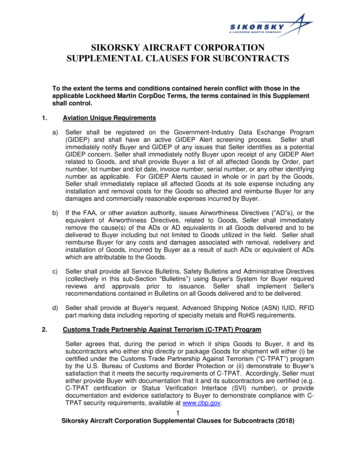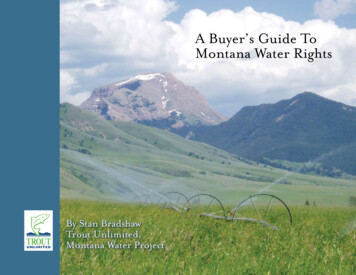
Transcription
A Buyer’s Guide ToMontana Water RightsBy Stan BradshawTrout Unlimited,Montana Water Project
A Cautionary TaleThis tale is based on real events. I’ve just changed the names, details of the water right, the specific facts of the dispute,and the location to avoid undue embarrassment to anyone.In 2002, Michael Hartman looked at a ranch for sale on a major tributary in the upper Missouri river basin. It was1100 acres with frontage on a trout stream, and it had an active sprinkler-irrigated hay operation on 160 acres. WhenHartmann was negotiating the deal, the realtor produced a water rights document entitled “Statement of Existing WaterRight Claim” (“Statement of Claim” for our purposes). It included a water right number, identified a flow rate of 10cubic feet per second (cfs), and 320 irrigated acres, complete with a legal description of the acres irrigated.It seemed like a great deal—nice property right on a famous trout stream, and a whole lot of water rights to work with.What’s not to like? So he bought it. After moving on to the land, Hartman looked at the acres claimed for irrigationin the Statement of Claim, located the 160 acres that weren’t currently being irrigated, and embarked on plans to startirrigating them. When he walked the land, he didn’t notice any sign of ditches or headgates on the quarter section hewanted to irrigate, but he figured, “Hey, it’s listed on the water right, so I have the water for it.” He approached theNatural Resources Conservation Service (NRCS) about cost sharing a new center pivot on the land and putting a pumpinto the ditch serving the other 160 acres, and they seemed interested.Well, his little valley was a small town and word got out about what he had planned. Some downstream irrigators, whowere having particular difficulty getting their water that year, contacted a lawyer. The lawyer wrote to Hartman, tellinghim that the property he wanted to irrigate had no history of irrigation, and that if he didn’t cease-and-desist (a favoritelawyer phrase), his clients would take Hartman to court.Hartman was stunned. “But, my water right says I can irrigate this land,” he thought. So he called his lawyer, whospecialized in real estate law, but had taken a course in water law at the University of Montana 20 years before. The lawyer,after perusing Hartman’s Statement of Claim, assured his client it was okay to irrigate that property.To shorten this up a bit, Hartman started to install his pivots and the downstream irrigators sued to stop him from usingthe pivot because he did not have a water right for the acreage he wanted to irrigate. Several thousands of dollars later, thecourt ordered Hartman to cease and desist because Hartman could produce no evidence that the land had been irrigatedand, notwithstanding the language in the Statement of Claim, he did not have a water right to irrigate those acres.The moral of this tale? First, don’t necessarily believe everything you read on that Statement of Claim—due diligencein searching water rights in Montana requires more than simply looking at your paper “water right” as Hartman did. And,by the way, don’t hire just any old lawyer to advise you on water law—hire one that specializes in water law. A Buyer’s Guide To Montana Water Rights
IntroductionThe ChallengeWelcome to Montana water law. To the casual observer, water law appears arcane, internally contradictory, illogical,and generally inaccessible to anyone not fully immersed in it. At one time or another it can indeed be all thosethings. Happily, however, you don’t have to be a water-law expert to avoid Hartman’s fate.The purpose of this guide is simple—to help you, the prospective buyer of Montana land, determine if any real waterrights go with the land you want to buy. One thing this guide won’t do is make you an expert. But it should help you asksome of the right questions when you’re looking at a piece of land with water rights.Table of ContentsMontana Water Law in a Nutshell3Performing Due Diligence on the Existence of a Water Right7Due Diligence Checklist14Township, Range, and Quarter Quarter Quarter Section:A Quick And Dirty Guide to Reading Legal Descriptions16Streamflow Restoration Options for Landowners1819Flood vs. Sprinkler: Which Consumes More Water?21The Statewide Adjudication:What Is It, and What Does It Have To Do With My Water Rights?22Resource Guide for Researching Water Rights23Profile of a Water Lease:A Little Bit of Water Can Go a Long WayA Buyer’s Guide To Montana Water Rights
The Language ofWater Law — AGlossary of KeyTermsThe conventional wisdom is to putthe glossary at the back of a report.Because so much of the philosophicalunderpinning of western water law isexpressed in its jargon, it makes senseto provide terminology at the frontend of the discussion. Read throughthese definitions now, and even thoughit won’t all immediately fall into place,you’ll find the rest of this guide easiergoing. At the very least, you’ll have afew water law terms that you can throwaround to impress your friends.Abandonment. Abandonment is theintentional, prolonged, non-use ofa water right, resulting in the loss ofthe right. See more under “MontanaWater Law in a Nutshell” below.Abstract (or “general abstract”).This is a term that you may hear used.It is another way to describe the“Statement of Existing Water RightClaim.” So if you hear the term usedelsewhere, that is what it refers to.continued on page 4 A Buyer’s Guide To Montana Water Rights
Montana Water Lawin a NutshellFirst in Time, First in RightLike most of the western United States, Montana operates under what is known as the doctrine of “prior appropriation.”Simply stated, this doctrine says that those who first put water to beneficial use get to continue using it first whenwater is scarce. This “first in time, first in right” priority system ensures that water users whose forebears firstput water to use—so-called “senior users”—can rightfully demand that their needs from a stream be fulfilled before theinterests of junior users. Some senior water rights in Montana go back to the late 1860s. In years when water is too scarceto satisfy all water rights, senior users get water and junior users often don’t. So the first take-home lesson is that not allwater rights are created equal. In a dry year, a 1910 water right for 10 cfs may not provide as much water to the user as an1875 water right for 2 cfs.Not all water rightsare created equal. In adry year, a 1910 waterright for 10 cfs may notprovide as much waterto the user as an 1875water right for 2 cfs.Beneficial Use—A Moving TargetAnother key provision of this doctrine of prior appropriation is that water must be put to a beneficial use. Whenthis system evolved in the arid west in the 19th century, “beneficial use” was largely defined by the act of diverting watersfrom the stream. Water left instream was widely consideredto be waste. A well-managed stream was a dry one. The ideaof water left instream serving a beneficial use didn’t begin tosurface in Montana law until the late 1960s. Now, in specificcircumstances, it is possible to acquire a legal water rightfor instream use for such things as the benefit of fisheries,wildlife, and water quality.One cautionary note about diversions and beneficialuse—some water right holders believe that simply divertingwater, even if they don’t apply it to a beneficial use, protectstheir water right from a claim of abandonment. It doesn’t.The key to protecting your claim to a water right is to apply itto a beneficial use. In the case of irrigation, for instance, thatmeans actually irrigating something other than the bottomof a ditch. Likewise, pouring enough water on fifty acres toirrigate 400 acres doesn’t establish a beneficial use in theexcess water. Your beneficial use is limited by the reasonableneed of the particular use.A Water Right is a Property Right.While it may seem contradictory at first blush, the Stateof Montana owns all the water in the state—the owners ofwater rights possess only the right to use some of that water.Here’s the crucial language in Article IX of the MontanaConstitution:A Buyer’s Guide To Montana Water Rights A Buyer’s Guide To Montana Water Rights
“All surface, underground, flood, and atmospheric waters within theboundaries of the state are the property of the state for the use of its peopleand are subject to appropriation for beneficial uses as provided by law.”Just because water arises on your land, you don’t have an automatic rightto use it. You must have a water right.The key to protectingyour claim to a waterright is to apply it to abeneficial use.Use it Or Lose it. So the state owns it, but we get to use it. Your right touse the water—your water right or appropriation right—has been recognizedas a form of property right. But it’s not like a piece of real estate or a new car:you have to use it. If you don’t use it—usually over a long period of time—youcan lose it. This concept of “use it or lose it” doesn’t mean it has to be usedevery year—a really junior right may only find available water every few years,and then only for a small part of the year—it’s still a valid water right; justnot a very reliable one. Disuse,coupled with some outward signof intent to no longer use thewater, can lead to abandonmentof a water right.A Montana SolutionKeep this concept of abandonment in mind as you consider the water rights claimed forthe property you’re examining.If you see an abstract that showsa claim for irrigated acres wherethere is no sign of any irrigationsystem or, if what is there lookslike it hasn’t been used since theadvent of the internal combustion engine, it should send up awarning flag.Photo www.kestrelaerial.com A Buyer’s Guide To Montana Water RightsAcre-foot. This is a term usedto describe a volume of water. Anacre-foot equals 325,851 gallons, orenough to cover one acre in one footof water (43,560 sq. ft., or about thesize of a football field). An acre-footis also enough water to meet thedemands of a family of four for a year.Adjudication. In the context ofMontana water law this refers to thestatewide judicial proceeding to determine the type and extent of all waterrights claimed before July 1, 1973. Seethe sidebar below on the adjudication.Adverse effect. In water rights,something that impedes the ability ofa water user to make use of water.Change in use must avoid an adverseeffect to other water users.Appropriate. The acts necessaryto create a water right.Appropriation right. A long-windedway of saying water right. A water rightis a right to put water to a beneficial use.Appropriator. One who applieswater to a beneficial use. Anappropriator owns a water right.Beneficial use. A use of water forthe benefit of the appropriator, otherpersons, or the public, including butnot limited to agricultural (includingstock water), domestic, fish and
wildlife, industrial, irrigation, mining,municipal, power, and recreational uses;a use of water to maintain and enhancestreamflows to benefit fisheries pursuantto conversion or a lease of a consumptiveuse right. Note: simply diverting waterdown a ditch and letting it run back tothe stream is not a “beneficial use.”Change in appropriation right.A change in the place of diversion, theplace of use, the purpose of use, orthe place of storage of a water right.These changes need the approval ofthe Department of Natural Resourcesand Conservation (DNRC) to assurethat the change will cause no adverseeffect to other water users.Consumptive use. A beneficial use ofwater that reduces the source of supply,such as irrigation or municipal use.Cubic feet per second (cfs). 448.8gallons per minute. Cfs is a measurementof flow. A flow of 1.0 cfs over 24 hourswill yield a volume of 1.98 acre feet.In a similar vein, a declaration of intent to use a water right, by itself,does not establish a water right. A water right has to be perfected by actuallyputting it to a beneficial use. In the 19th and early 20th century, it was possibleto file a notice of a water right in the county clerk’s office. Miners, often withan excess of wishful thinking, were particularly fond of doing this. In manycases, that is all that ever happened—no ditches were dug or water diverted.To put it kindly, the validity of those water rights is highly suspect.Just because water ariseson your land, you don’thave an automatic rightto use it. You must have awater right.Water Rights Are Transferable. A lot of water rights traditionalistsrepeat a common refrain, “Water runs with the land.” The statement is onlypartly true. If you own a piece of real estate, and it has water rights on it, whenyou sell that real estate, if you don’t mention the waterrights in the conveyance, the water rights automaticallytransfer to the buyer of the real estate.Some old timers want to believe that this means thewater right can never be severed from the land. Thatisn’t true, and hasn’t been true since at least 1895.Water rights can be transferred to new places of usetotally unrelated to the original real estate. But there’sa catch.Any change in the purpose, place of use, or placeof diversion of a water right must first be approvedMontana Department of Natural ResourcesConservation. Prior to 1973, if you wanted tochange the place of use, purpose, or point of diversion,you just did it. While you had an obligation not to doanything that would adversely affect the water rights ofothers, you didn’t have to seek any prior agency approvalto do the change. If you harmed somebody, they hadthe option to sue you after the deed was done. In 1973however, with the passage of the Montana Water UseAct, that all changed. Now, if you want to change thepoint of diversion, place of use, or purpose of use ofby the1.0 cfs 448.8 gpm 40 miner’s inches1.0 cfs x 24 hrs 1.98 acre feetDNRC. The Montana Department ofNatural Resources and Conservation,the state agency responsible forpermitting new water rights andchanges in appropriation rights.continued on page 6andA Buyer’s Guide To Montana Water Rights
your water right, you have to first secure DNRC’s approval, and the burdenis on you to prove that you won’t adversely affect the water rights of anyoneelse. And step one in providing that proof?Historic use of a water right—not what an Documenting historic use. Ultimately, it’sbit more complicated than that—there isabstract, or even what a court decree says—is key to asomehydrology involved—but a key part ofestablishing the extent of a water right. granting a change is assuring that there won’tbe any expansion of use over what historicallyoccurred. So, back to our cautionary tale at the beginning, any proposedchange which will expand the amount of water diverted or consumed mighthave an uphill battle getting DNRC’s approval if there are any downstreamwater rights.Historic use of a water right—not what an abstract, or even what a courtdecree says—is key to establishing the extent of a water right. So, when youembark on due diligence research of a water right, one fundamental goal isget a handle on what the actual historic use was.Flow rate. A measurement of therate at which water flows are diverted,impounded, or withdrawn from thesource of supply for beneficial use, andcommonly measured in cubic feet persecond (cfs) or gallons per minute (gpm).Put in every day terms, when you turn onthe faucet in your kitchen sink, the watercomes out at a certain rate of flow (gpm).Instream flow or use. Water left ina stream or river for nonconsumptiveuses such as a fishery use.Junior Appropriator. A secondaryuser on a water course. One whodoes not have the most senior rights.Miner’s inch. An archaic descriptionof flow rate that you’ll occasionallyhear. In Montana, one cfs equals 40minor’s inches. Or one miner’s inchequals 11.22 gallons per minute. Onecaveat for the strict constructionistsamong you—a miner’s inch in Montanaisn’t necessarily the same a miner’sinch in another state. Why? Go figure.Nonconsumptive use. A beneficialuse of water that does not reducequantity, quality, or timing of water in thesource of supply, such as an instream use.NRCS. The Natural Resources Conservation Service. This is the federalagency that implements the federal farmcontinued on page 8 A Buyer’s Guide To Montana Water Rights
Performing Due Diligence on the Existence of a Water RightWhat follows in this section is a step-by-step guide to researching the validityof water rights claims attached to a piece of land. This does not cover everysingle aspect of a due-diligence inquiry, but rather those things that arereadily accessible to an interested prospective buyer. There are a number of usefulsteps omitted here—examination of tax records, close examination of 19th centuryfiling documents, comparison of claimed flow rates with measured ditch capacity,or a review of electrical records where irrigation is powered by electricity, to name afew—that are better done by a trained professional. But if you follow the suggestionsin this section, it should substantially improve your understanding of the waterrights that attach to a property and help you decide whether you need professionaladvice on the water rights aspect of your purchase.The bottom line is to establish actual use. Because the people who firstestablished most water rights of any early priority are long since dead, and becausevery few irrigators actually measured the amount of water they diverted and appliedto their fields, establishing historic use can be a challenge. The most accessibleapproach to establish the existence of an irrigation claim (and one which hasbeen accepted by DNRC) is to look at acres historically irrigated. There is nosingle magic source for establishing historic use—it is usually an accumulationof sources.While much of this can be easily be done by the prospective purchaser,if the water right claims are a key part of a parcel’s value, you should seriouslyconsider hiring a consultant or attorney who specializes in water rights toconduct the search.1) Get Copies of the Statement of Claim.Virtually every consumptive use water right claim is in the MontanaDNRC database and available for viewing on line at: http://nris.mt.gov/dnrc/waterrights/default.aspx. (See the Resource Guide on page 23). The statementof claim that you find there will be an abbreviated version of the completestatement, but you can request via email a complete copy of the full statementof claim. Remember the numbers you see here—flow rate, volume, and acresA Buyer’s Guide To Montana Water Rights
irrigated—don’t necessarily accurately represent the extent of the water right.This is just what a prior owner has asserted as a claim—it may or may not beaccurate.In many instances—especially when the adjudication has progressedbeyond an initial filing—you may find text at the bottom of the abstract thatcan provide some hints as to the validity of the historic use claims. These arecalled “issue remarks.” DNRC, after examination of the claim, has placedthem on the abstract. For example, a common issue remark is “THIS CLAIMPRESENTS ISSUES OF LAW AND FACT THAT MAY BE ADDRESSEDAT THE OBJECTION STAGE. IT APPEARS THAT ACRES [insteadof the acres claimed on the abstract] ARE ACTUALLY IRRIGATED, ANDPROBLEMS COULD EXIST WITH THE FLOW RATE AND PLACEOF USE.” If you see a comment like this, you’ll want to see what claimsexamination was done to prompt such a comment, and that informationshould be available in the regional DNRC office.2) Review the original 1982 water right claim file and the materialsubmitted in support of it.The statement of claim that you obtained at step 1 shows what thewater user claimed for the water right in 1982 as part of the statewideadjudication.As of 2006, that adjudication has yet to be completed in any basin.The information on the abstract likely also includes any adjustments to theoriginal claim made as a result of any proceedings in the adjudication. Youcan see the detail behind the abstract by going to the records on file at theDNRC headquarters in Helena (phone 406-444-6694), at the State WaterCourt Offices in Bozeman (406-586-4364), or at the regional DNRCWater office that covers the water right in question. The file might includethe claim document, supporting evidence, maps, or air photos. It might alsoinclude DNRC claims-review documents and field reports. At times, theclaims review notes can be a bit cryptic—if you have trouble understanding A Buyer’s Guide To Montana Water Rightsbill, and has local and regional officesaround the state. It is a source ofinformation and assistance on agriculturalirrigation practices, soil types, weedcontrol, grazing practices, and otherranch management issues. It also hasa variety of programs providing partialfunding for irrigation improvementsand some habitat restoration.Perfected. A water right claim isperfected when it is actually put to use.Under the traditional system one couldfile a notice of a claim in the countyclerk and recorder’s office withoutfirst having put the water to use. Andunder the modern permitting system(since July 1, 1973), an applicant for awater use permit must get DNRC approval before putting the water to use.In either instance, if the water is notsubsequently put to use, then the waterright has not been perfected, and it maynot be valid. Remember, a water rightis defined by its actual beneficial use.Good intentions don’t count for much.Place of Use. The place at whicha water right is put to use.Point of Diversion. The place on awater source at which water is diverted.Senior appropriator. As between twoor more users on a source, the wateruser with the earliest priority date.Return flow. Part of a diverted
flow that is applied to irrigated landand is not consumed and returnsunderground to its original source oranother source of water, and to whichother water users are entitled to acontinuation, as part of their water right.Volume. On the Statement of Claim,the volume of the water right is indicatedin acre-feet (see definition above). Thisindicates the total amount of water thatcan be diverted from the stream at thespecified flow rate. In many cases, youmay see this comment on the “maximumvolume” line on the Statement ofClaim: “The total volume of this waterright shall not exceed the amount putto historical and beneficial use.”Waste Water. That part of a divertedflow which is not consumptively usedand which returns as surface water toany surface water source, and whichother water users can appropriate, buthave no legal right to its continuance.For example, if an irrigator puts somuch water on his field that some ofit flows off his land as surface flow,that surface flow is waste water.Water Court. Located in Bozeman,the Water Court’s primary function isto carry out the state-wide adjudication.Disputes between water right holdersare still handled in local district court,and the local district courts still overseeany water commissioners in their area.them, ask for help from DNRC personnel. Often the detail you find is notof much help, but it’s still worth a look. When you visit any of these offices,the office can give you an update on the status of the adjudication and howit might affect the claims you are examining.One useful item that may surface as part of this inquiry is an old courtdecree. Historically, if people had a water rights dispute, parties would suein district court to resolve it. Many—but far from all—streams have somehistoric water rights decree that apportions water use among the water userson that stream. While it is not conclusive evidence of historic use, it isanother helpful piece of evidence that the water right was indeed put to useat some time in its claimed history.3) Review the current deed to the property to assure that no water rightshave been reserved (severed) from the land.Remember, In Montana, unless expressly stated otherwise, water rightsattached to land will pass with the conveyance of the land, unless the water rightholder expressly exempts the water right from the conveyance. So notwithstandinganything else you have heard, it’s good to peruse the deeds to the land tomake sure none of the water rights have been reserved from conveyance tothe current owner.4) If the water rights are represented by shares in a ditch company orirrigation district, check with the ditch company or irrigation district toconfirm status of the shares.If the current owner indicates that the water for the land you are lookingat is provided by an irrigation district or ditch company, ask to see theowner’s records concerning those shares. And get the name and addressof the ditch company, along with any key personnel or phone numbers,so you can conduct your own examination of the shares that attach to yourA Buyer’s Guide To Montana Water Rights
land. Among other things, you’ll want to make sure that anyannual assessments have been paid.5) Review the Montana Water Resources Survey Maps for thetownship and range in which the water right claims a place of use.In the 1940, 50s, and 60s, the State Engineer’s Office(predecessor to DNRC) surveyed water use in most countiesin the state. The results of these surveys were published andexpressed as water rights maps that show ditches and irrigatedacres. The maps were derived from aerial photos taken in ayear close to when the publication occurred (the’ 30s, ‘40s,‘50s and ‘60s), so they represent a snapshot of water use. Ifthe land claimed to be irrigated on your water right abstractdoes not show up as irrigated on the Water Resources Survey,take that as an early warning. Had Michael Hartman in ourcautionary tale taken this step, he might have saved himselfa lot of grief. If you draw a blank on the Water ResourcesSurvey map, don’t automatically assume that the land inquestion wasn’t irrigated—but you may have to look to otheraerial photos to see if any of the claimed lands show up asirrigated in other years. You can look at Water ResourcesSurvey maps online by going to: www.dnrc.state.mt.us/wrd/home.htm.6) Look at other aerial photos.Part of due diligence is establishing that there has beensome continuity of use of a water right—not that it has justbeen used for one year (e.g. the year of the water Resourcessurvey) and never again. One way to do this is to look atother aerial photos. Two sources of aerial photos are (1)the DNRC regional offices (they will have aerial photos for10A Buyer’s Guide To Montana Water RightsIrrigation activity is often readily identifiable on aerial photos. NRIS photo.their particular region); and (2) the water rights websitefor the water rights claim in question (see item 1 above). Byclicking on the “use count” box in the water rights list, youcan generate a water rights map that can then be convertedto an aerial photo (typically with a 1995 and a 2005 photodate) that can provide some guidance as to recent use. Thereare a number of other sources of aerial photography, but ifyou need to go to that much effort and level of detail, youmay want to consider hiring a consultant.
7) Look at topographical maps.One useful exercise is to look at a topographical mapof the ground claimed to be irrigated. Most irrigationclaims, even if they are now perfected through some kindof pump and sprinkler system, started as flood irrigation.Flood irrigation relies on gravity. For a flood system towork, the water has to flow downhill. And that’s where thetopographical map comes in handy. If a parcel that has beenclaimed to be flood irrigated sits higher than the sourceclaimed to irrigate it, that claim of irrigated land is, to put itkindly, suspect. And, indeed, such claims have been filed. Inaddition, many topographical maps will show some evidenceof irrigation canals.8) Ask the seller for a map that highlightsthe property for sale and then comparethat map to the irrigated acres describedin the Statement of Claim.Over the years, if the property has been split, part of theland irrigated may not be on the parcel you are considering,and that may not necessarily have been reflected in theconveyances. It is possible that there may be more than oneperson claiming the right.9) Check the legal descriptions ofthe points of diversion against thelegal description on the land thatyou are considering buying.If you see an abstractthat shows a claim forirrigated acres wherethere is no sign ofany irrigation system,it should send up awarning flag.If the points of diversion and ditches are not on theprospective property, you will want to check for any easements onthe property where the points of diversion and ditches reside.10) Do a site visit.If you’re serious about purchasing land, you will nodoubt be visiting the site. In a perfect world, you will haveread this guide, done your office homework on the waterrights, and come prepared to closely scrutinize any evidenceof water use at that first visit. If not, plan a second visit andIf the place of use is in section 1 (4300--4400 feet elevation) and thepoint of diversion is in section 11 (under 4300 feet elevation), Section 1couldn’t be flood-irrigated from section 11.A Buyer’s Guide To Montana Water Rights 11
come with a camera, a topographical map, copies of thewater rights abstracts, the Water Resources Survey map, anda note pad.When you’re on the ground, make sure you see any current irrigation operations, and try to correlate them to thelegal descriptions of irrigatedground found on the claim abstract. Ask to see any old diversion sites, ditches or other irrigation works, even if they arenot currently in operation. Takepictures. Ask questions about thehistoric use—what was irrigated,what crops were grown. Determine if there are any old timersaround who can talk about whatthe irrigation practices were. Askabout any historic records—journals, irrigation records, etc.—that might shed light on the historic water us
A Buyer's Guide To Montana Water Rights First in Time, First in Right Like most of the western United States, Montana operates under what is known as the doctrine of "prior appropriation." Simply stated, this doctrine says that those who first put water to beneficial use get to continue using it first when water is scarce.
